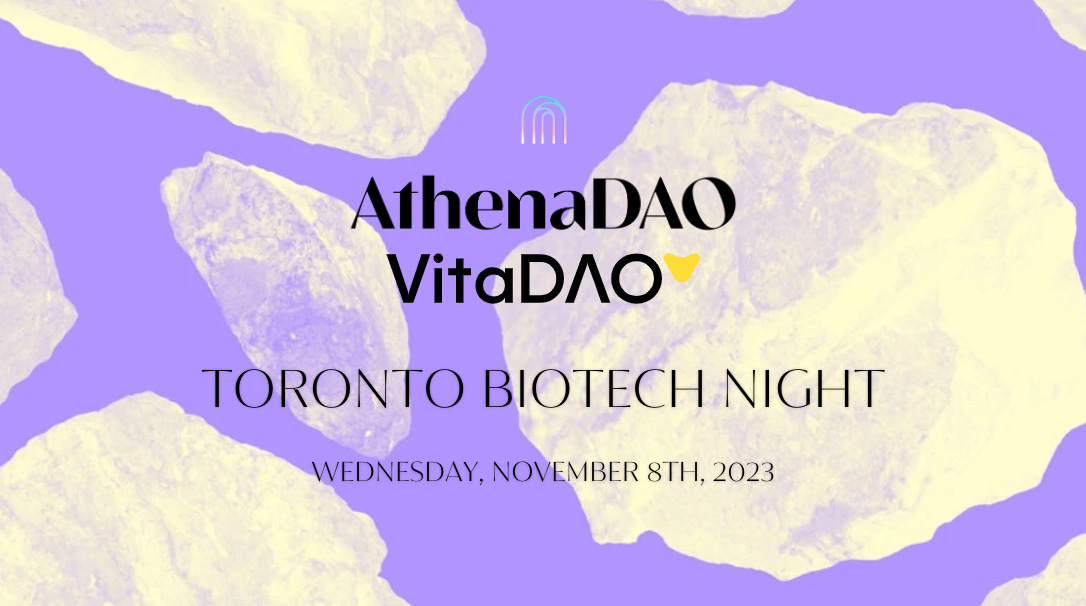In conversation with a Neuroscientist researching hormones 🪩🧬
Learn more about our upcoming events in Toronto, Los Angeles, and our author's book club
In conversation with a Neuroscientist 🧠
Dr. Samantha Cote is an outstanding member of the Department of Pediatrics, Department of Nuclear Medicine and Radiobiology, Faculty of Medicine at the Université de Sherbrooke. We also are fortunate to count her as part of the AthenaDAO Science and Dealflow WG! She recently published a paper titled: “Association of Cumulative Lifetime Exposure to Female Hormones With Cerebral Small Vessel Disease in Postmenopausal Women in the UK Biobank” in the prestigious journal Neurology.
We had the chance to talk to her about her work and her inspirations in women’s health. Below is the conversation that ensued:
Q. Why are you interested in women’s health?
A: I am interested in women’s health because as women we make up 50% of the population but have been largely ignored by the medical and scientific communities. A recent paper showed that in 2019 only 3% of psychiatric and neuroscience studies published in leading journals were conducted in only females yet there are uniquely female experiences (pregnancy, oral contraception, menstrual cycles) that have direct effects on the brain. I want to better understand how these unique experiences, especially how differences in hormones women experience influence cerebrovascular health so we can better treat and prevent cerebrovascular disease in females. Currently, there are no guidelines or risk assessments that take into consideration hormone exposure and reproductive history. I think this needs to change.
Q. How did you get involved in women’s health? What’s your story?
A. I started working in women’s health during my Master’s degree. I was interested in hormones because of their ability to influence neuronal activity. As I began my research on the influence of hormones on the brain I discovered that the effects of hormones extended beyond influencing neuronal activity and that hormone states have a significant impact on cerebrovascular disease striking neuroprotective effects. However, the vast majority of these studies were conducted in male rodents, and the influence of hormone states in female humans remained largely unstudied. Thus, I decided that during my PhD, I wanted to focus on studying the influence of hormone states on human female cerebrovascular health and function to address this knowledge gap.
Q. Could you give us a 1 paragraph summary of your research?
A. The study was conducted on 9163 postmenopausal women of the UK-Biobank Initiative who had MRI scans. We used their reproductive history (when they had their first period, menopause and how many children they had) to estimate how many years they were exposed to hormones. Using this estimate we examined how their hormone exposure was related to an MRI biomarker of cerebral small vessel disease while accounting for cardiovascular risk factors, age and sociodemographics. We found that women with higher exposure to hormones had less cerebral small vessel disease.
Q. What do you think the next steps in your research are? What about the next steps we should be considering for this field when it comes to women’s health?
A. Overall, we still do not have a clear idea of how different hormone states that women experience influence their health. To take our research to the next step I think we need to use the information that studies like mine tell us and create clinical tools or guidelines that take into consideration a woman’s reproductive history and the hormonal states she experiences when we are assessing risk for cerebrovascular disease and incorporate it into personalized preventive medicine. A clinical trial that evaluates if this improves cerebrovascular outcomes for women would be the next step to developing clinical tools and guidelines. Second, there are many states I did not study, such as the influence of PCOS, adverse pregnancy-related outcomes, use of assisted reproductive technology, and types of hormonal contraception. Millions of women worldwide will experience these states and yet we have largely ignored how they influence the female brain. I want to understand how experiencing these different states may change the brain and if some can be protective. Lastly, our exploratory results are really interesting and suggest that perhaps hormone therapies can have a beneficial effect on the brain. However, we still need to understand how and why topical HRT is associated with lower signs of cerebrovascular disease in the brain. It might just be that there is a specific characteristic about the women who sought hormone therapies applied topically that is protective and not the therapy itself.
Q. How can everyday women learn more about their reproductive history?
A. Their reproductive history is their lived experience. A great way to learn more about your reproductive history is to track your experiences, what are your menstrual cycles like, what are your pregnancies like, and what are your symptoms. Applications like Clue are really helpful with this and their website provides a lot of useful information that can help you understand what you are experiencing.
Q. Do you have any inspirations in women’s health? Is there anyone who is working on something you find particularly relevant/urgent?
A. I am inspired by the team leading the Apple Women’s Healthy Study, Michelle A Williams, Shruthi Mahalingaiah, Russ Hauser and Brent Coull. One of the difficult parts of studying women’s health is that they need to be longitudinal and also include a very large sample to tap into the large inter-individual variability in how and when women experience different hormone states. This study follows thousands of women across the world with data collected daily, monthly, quarterly and yearly. This rich dataset will shed light on many answered questions on how menstrual cycles and reproductive life events affect women’s health. There have been a handful of studies from this cohort that have been published and I cannot wait for their future studies.
Q. You mentioned you found preliminary results in an exploratory analysis that topical HRT is also protective. What does this mean? Why is this exciting? How does this compare with other studies involving HRT that you’ve looked at?
A. Our preliminary findings show that women who were taking topical HRT (i.e. patch or gel-based HRT) had fewer signs of cerebrovascular disease on the MRI scans that we analyzed. This might suggest that taking topical HRT could prevent or slow down the development of cerebrovascular disease. This is in contrast to other population-based MRI studies that had a similar design to ours, which found no effect of HRT. We believe this is because other studies did not consider the route of administration. In fact, if we do not consider the route of administration, we also find no effect. This highlights the importance of considering how and what type of hormones women are taking. While these results are really promising, they included only one-time point and it was not randomized nor blinded. There could be other factors at play. If our findings hold true, and topical HRT is protective it could mean that we have a new avenue to explore to prevent cerebrovascular disease in women. This is important because cerebrovascular disease risk increases significantly after menopause, and women are more likely to have long-term sequelae and die of stroke than men even though men are more likely to suffer from stroke than women.
Q. What are the biggest gaps preventing further progress in your research that you’ve come across?
A. There are two gaps that I think are preventing progress in research like ours on the influence of reproductive history on women’s health. First, Prospective Cohorts like the UK Biobank are a goldmine for researchers. However, many of these databases were not constructed with questions about female health in mind. For example, we are lacking information on breastfeeding which influences the return of regular menstrual cycles. There are also many perimenopausal women in the UK Biobank, we have information on their last cycle and the average length but there are no questions about menstrual cycle regularity at any of the visits. Having this type of information with the risk imaging, genetic and physical measures would really push the field forward. I think initiatives like the Apple Women’s Health Study will help fill these gaps. Second, Hormone exposure is dynamic and depends on many factors. All females are different, and yet most of the data we have available and the studies that exist look at one cycle or one-time point. We will need more studies that evaluate how the brain and women’s health in general changes in time with their hormones to understand how our reproductive history influences our health and how it changes with time.
Q. What advice would you give to someone who wants to learn more or even pursue a career in women’s health research?
A. If there is a specific type of research or methodology that you like, find a researcher who works in that field and is receptive to the idea of studying hormones and women’s health. When I joined my lab, my supervisor had never thought that hormones could influence the brain but was open to testing the idea. I convinced him to take a chance on me and the influence of hormones on the cerebrovascular system. Using his expertise in image processing and MRI physics and my passion for hormones we were able to bridge the gap and study how hormones impact the cerebrovascular system in women at different stages of their lives. Now understanding how hormones influence the cerebrovascular system has become a cemented research topic in the laboratory. Additionally, If you ever see a researcher who is studying a topic in women’s health that interests you, reach out to them, you never know what opportunities are currently available in their laboratories or someone they know who might be looking for students or a research assistant. You can also follow organizations such as the Women’s Health Research Cluster currently run out of the University of British Columbia and AthenaDAO’s socials which highlight researchers and companies in the field of women’s health.
If you are interested in talking with Dr. Samantha Cote, you can reach out to her via her website.
This interview was conducted by Victoria Dmitruczyk.
Join us for breakfast in Los Angeles! ☕️🌴
On Friday, November 3rd at 12:00 pm PST, we will be having an LA-time community breakfast (late breakfast 😄) in Santa Monica, California. We had some amazing community breakfasts throughout the world in September. Don’t miss out! 🚀
Join us in Toronto for a Biotech Night with Innoco Club! 🧬
On Wednesday, November 8th, we’ll be joining Innoco Club In Toronto as co-hosts to a biotech night in Toronto! Be sure to come by for a night of exciting conversations, lighting talks, and discussions that will leave you inspired.
Meet Evolutionary Geneticist and author Dr Deena Emera! 📚
Part of our unlock on $ATH token utility is giving access to leaders in women’s health to our community. We are hosting a limited series of AthenaDAO’s Author Book Club, where we get to meet prominent names in science!
For our inaugural session, we'll be joined by Dr. Deena Emera, the author of: "A Brief History of the Female Body: An Evolutionary Look at How and Why the Female Form Came to Be".
Deena Emera, PhD, is an evolutionary geneticist, author, and teacher. She earned a bachelor’s degree from UC Berkeley, a master’s degree from NYU, and a PhD from Yale. She currently serves as a scientist and writer-in-residence at the Buck Institute’s Center for Reproductive Longevity and Equality. In her new book A Brief History of the Female Body, Deena draws on her expertise as a biologist and experience as a mother of four to explore the mysteries of the female body through an evolutionary lens.
Spaces are limited.





